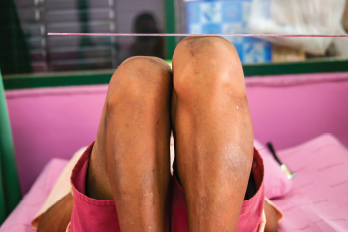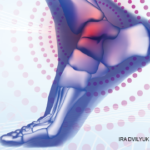
Tridsanu Thopet / shutterstock.com
Humans are not perfectly symmetrical. Almost everyone has one ear that’s higher or one foot that’s larger than the other. Similarly, leg lengths are often not quite the same. There is disagreement as to what constitutes a clinically significant difference, but some studies suggest that leg length discrepancy (LLD) can lead to osteoarthritis (OA) of the hip or knee.1-3
Providers use different methods to diagnose LLD, although a physical exam is a common place to start, followed by imaging studies for precision. Different providers have varying views regarding how (or whether) to treat LLD and look at many factors to get the most precise diagnosis and beneficial treatment plan.

Dr. Shams
Incidence & Causes
There’s an old story about a patient who goes to see his doctor with pain in one of his knees related to OA. At the visit, the physician explains to the patient that OA is essentially aging of the knee joint. So the patient says, “Doc, my other knee is the same age as this knee. How come I have it in one knee and not the other?”
This question about why one knee ages more than its twin may be explained by inequalities in leg length. While 20 mm of difference is a regularly cited metric, the level of clinical significance is an issue of debate among researchers: Some say even 5 mm is significant, and others say 20 mm or more is.4 This disagreement contributes to a wide variation in published prevalence rates, which range from 4% to 95%.4 One literature review notes that about 59% of the population has a discrepancy of at least 5 mm, but that the majority of cases are mild, at less than 20 mm.1
This question about why one knee ages more than its twin may be explained by inequalities in leg length. While 20 mm of difference is a regularly cited metric, the level of clinical significance is an issue of debate among researchers: Some say even 5 mm is significant, and others say 20 mm or more is.4 This disagreement contributes to a wide variation in published prevalence rates, which range from 4% to 95%.4 One literature review notes that about 59% of the population has a discrepancy of at least 5 mm, but that the majority of cases are mild, at less than 20 mm.1
There are two general forms of LLD: structural (or anatomical) and functional (or apparent).
Structural LLD is a physical difference in limb length that can be caused by such factors as abnormal growth, a break or trauma to the growth plate during childhood or from surgery.
Comparatively, functional LLD is caused by physical factors, such as muscle weakness or stiffness, reduced flexibility or abnormal joint function.
A third form, environmental LLD, is caused by external factors, such as running on a banked surface in one direction for long periods of time. This form of LLD tends to be grouped with functional LLD in the literature.

